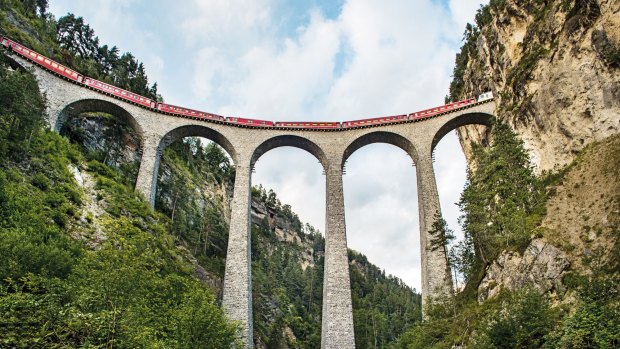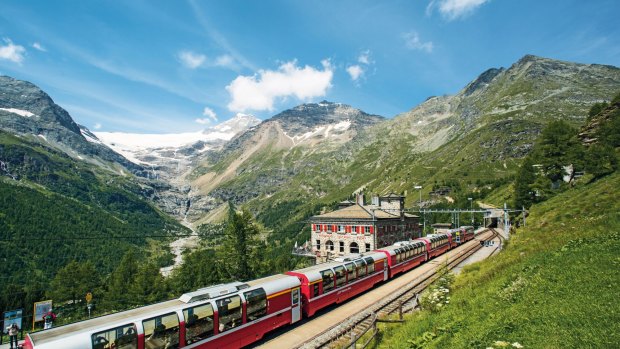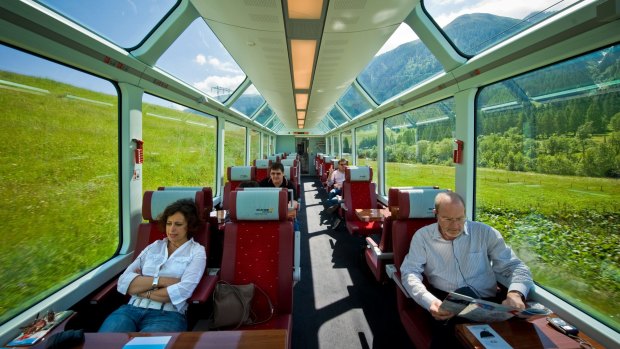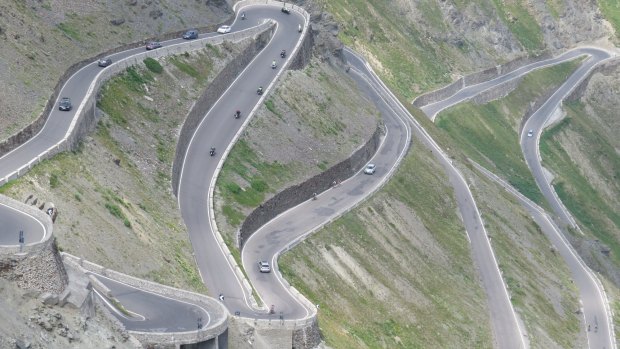This was published 8 years ago
Travelling Switzerland by train: The eight most scenic rail routes for a Swiss alpine journey

The Bernina Express travels along the Landwasser Viadukt at Filisur which is 65m high and 136m long.
It's still breakfast time when I board the Glacier Express, settle into the dining car and spot an irresistible challenge within the menu. "After dining, don't miss the truly unique artistic interlude performed by the hostesses: from a height of 60 centimetres – and while the train is in motion – they skilfully pour a range of the finest liqueurs such as grappa, Pflumli plum liqueur, Kirsch and Williams." Hang the early hour – this is something I have to see. If I were riding the Glacier Express all day (it connects the glamorous mountain resorts of St Moritz and Zermatt), I'd eat lunch before ordering a shot or two. But I'm jumping off this train at 9.27am to switch to a bus then a train then a bus that will take me to Lake Como (the more direct St Moritz-Lake Como Palm Express bus service was booked out). Being Switzerland, you can time everything down to the minute so I order my drinks (a prosecco and a plum liqueur, figuring I can mix a cocktail if the liqueur is too hair-raising) at the last possible moment – 9am.
In my carriage, there's a host rather than a hostess on duty – and he's clearly done the long pour before. He waits for me to ready my camera then holds the bottle close to the glass, drawing the bottle skywards still bottoms up. I feel a few splashes but the liqueur is clear – no damage done. The bottle is righted with a flourish and I applaud, for it's quite the spectacle.
Perhaps the host adds a little extra showmanship because he's competing with what's outside the panoramic windows – namely, extreme alpine scenery. This year, eight of the country's most scenic rail routes were bundled into a 1200-kilometre itinerary known as the Grand Train Tour of Switzerland – a name that evokes the romance of yesteryear. On a map, the routes resemble an Etch-a-Sketch drawing – they veer across the country diagonally, include several sweeping circular routes and can be started from any point at any time of the year.

The Bernina Express. Bernina Express: Chur-Tirano. Alp Gruem, Poschiavo.
Armed with a single ticket, the Swiss Travel Pass, I'm exploring the scenic routes criss-crossing Graubunden – the country's largest canton (or state) in the south-east corner bordering Italy, Austria and Liechtenstein. The travel pass, good for trains, buses and boats, can get you to most places in the country but certain panoramic trains, such as the Glacier Express and Bernina Express, require seat reservations.
After flying into Zurich in the north, I'm heading to Klosters. A railway travel centre underneath the airport prints out a personalised Fahrplanauskunft (timetable) outlining my journey. I can take the 7.13am into Zurich's main train station, where I have 14 minutes to catch the train to Landquart then six minutes to wait for the train to Klosters Platz. It's exhilarating making these sometimes tight connections, which I'd never trust to work in Australia. Perhaps it helps that the country's iconic station clocks are all synchronised to a central master clock. Hooray for Swiss precision.
We explore Klosters – where Prince Charles has skied over the years – before heading to Davos, where Thomas Mann set his epic 1924 novel, The Magic Mountain. With a swipe of our Davos Klosters Card (available to summer guests staying in commercial accommodation), we ride the Parsenn funicular to reach the Weissfluh summit, which at 2843 metres feels like the rooftop of Europe. We survey the surrounding peaks and the long narrow valley floors that humans have tamed; at our feet, jewel-like wildflowers spring from between rocks. On our way up and down the four-kilometre funicular track, we scan the hillside for ibex – the magnificently horned goats that symbolise Graubunden – but they're nowhere to be seen.

Glacier express passes through Canton Valais.Credit: Alamy
It's single-digit temperatures up on the mountain but Davos, Europe's highest city at 1560 metres above sea level, is unusually warm. We stroll to the lake that doubles as a beach: people are splayed on the plush lawn in their swimmers, working up a tan, while hardier types are braving the waters to sail and paddle-board. The bar is doing brisk business: we guzzle BrandLoscher lager from the Appenzell region to the north and stretch out our limbs. Life couldn't feel better. I blame the beer for what happens next. We're due at Davos' transit hub to catch a bus to the romantic Sertig Valley for dinner. Some of us dawdle – we have neither wristwatch nor a care in the world. Pots of flowering edelweiss snag our attention. Next thing you know, our companions are aboard the last bus out and we're not. One eye-wateringly expensive 11-kilometre taxi ride later (CHF62; $90), we spill out of the vehicle and stop dead in our tracks. The glacial valley is dramatic in its own right but, in the next paddock, bell-toting cows are knocking out a symphony while pulling at the pasture. It's such a charming sound, amplified by the valley walls, that I forget my hunger pangs.
Restaurant Walserhuus serves regional specialties such as capuns – dumplings spiked with air-dried beef, wrapped in chard and served in a cream sauce. Next day's lunch is lighter. Over two hours and four minutes on the Bernina Express, we slide past lakes marking the region's watershed. The 2253-metre-high Ospizio Bernina station marks a linguistic boundary – from here, we're entering the Italian-speaking valley of Val Poschiavo. We tumble off the train at Alp Grum and into the station restaurant that serves a lasagne layered with wafer-thin pasta. Nothing could remind me more just how close we are to Italy. Views of the Palu Glacier and Lake Palu – as blue as a Tiffany's box – accompany the food.
To work off lunch, we hike an hour to Cavaglia. The village has capitalised on a natural phenomenon known as "glacial mills" – holes up to 15 metres deep gouged out of the granite by stones rotating under pressure from glacial water. A dedicated committee dug the rubble from 32 of the 102 holes to turn them into a free tourist attraction; more adventurous types can clamber into a hole via a ladder.

Stelvio line.Credit: Katrina Lobley
We continue down the railway line to Poschiavo – a town featuring ornate Renaissance-style residences that's bounced back from devastating floods in 1987. It's easy to while away a few hours over beers in the cobblestone main square, soaking up the charms of small-town life such as the passing pooch that laps from the fountain. After overnighting in Poschiavo, we're back on the red train to loop the loop at the circular Brusio viaduct before pulling into Tirano in northern Italy. It's meltingly hot after the alps – I could do with a gelato – but instead we cross the river Adda, admire the terraced vineyards overlooking the city and dive into the cool interiors of 17th-century Palazzo Salis. The noble family's home features ornate frescoes and trompe l'oeil, a private chapel and high-walled garden.
After lunching in Vineria Tirano's courtyard on chisciol (pan-fried buckwheat pancakes stuffed with cheese), bresaola, local Valtellina wines, bisciola (slices of berry-studded bread) and more, we roll onto the Stelvio Line bus (reservations essential) to zig-zag through 75 hairpin turns back into Switzerland. The road, the Alps' second-highest paved pass, peaks at 2757 metres and is open only from June to September. Cyclists, motorcyclists and motorists flock to tackle its challenges but, if you're prone to travel sickness, pack a preventative.
The end of the line is Mustair, which is almost as east as you can get in Switzerland. The village is home to about 750 people (most speak Romansch as their first language) and a World Heritage-listed attraction: the 1200-year-old Convent of St John. Mustair is in Switzerland's Biosphere Reserve – an area so naturally endowed that it attracts brown bears and bearded vultures.
For my final Swiss stop, I'm off to commune with a different type of bird – the culture vultures that descend on glitzy St Moritz for the annual Festival da Jazz. One bus and two trains later, I slide into another valley and another world – right on time, of course.
TRIP NOTES
MORE INFORMATION
GETTING THERE
Fly Qantas or British Airways to Singapore; Swiss Air flies direct from Singapore to Zurich. See www.qantas.com.au ; www.ba.com; swiss.com.
GETTING AROUND
The all-in-one Swiss Travel Pass starts from $274 an adult for three continuous days' travel in second-class; passes range up to 15 days' travel within a month ($629 in second-class). Other benefits of the Swiss Travel Pass include half-price travel on cable cars and mountain railways not included in the network, and free admission to more than 450 museums. www.myswitzerland.com/rail.
STAYING THERE
In Klosters, rooms at Hotel Vereina start from CHF162 a night. In Poschiavo, the antique-filled Hotel Albrici dates from 1848 (take a stickybeak at the timber-panelled Sala delle Sibille dining room); from $204 a night. Poschiavo's Croce Bianca features singles, doubles and two charming new suites with larch floors and bedrooms with free-standing bathtubs; from $124 a night. See www.hotelvereina.ch; www.hotelalbrici.ch or croce-bianca.ch.
RAIL HIGHLIGHT
The Bernina Line, which drops 1824 metres between Ospizio Bernina and Tirano, is famous for its looped track. The connecting Bernina and Albula lines are World Heritage-listed – their impressive high-altitude structures include 196 viaducts and bridges, and 55 tunnels and covered galleries.
The writer travelled courtesy of Switzerland Tourism.
Sign up for the Traveller Deals newsletter
Get exclusive travel deals delivered straight to your inbox. Sign up now.